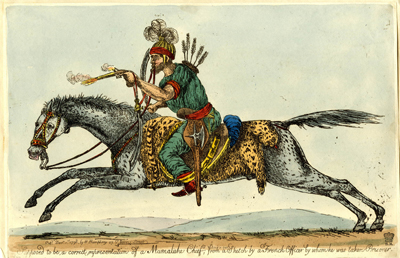Supposed to be a Correct Representation of a Mamaluke Chief
The Mamalukes (or Mamluks) were a warrior caste, whose Governors or Beys ruled various parts of the middle east in Gillray's time. Consequently, they were Napoleon's first obstacle when he decided to invade Egypt as part of his grand plan to cripple British trade with India during the Napoleonic wars. According to one of his lieutenants, Desvernois, who got his first glimpse of them barring the path to the Nile on the morning of July 13, 1798, the Mamalukes are
covered with dazzling arms, inlaid with gold and precious stones. Their costumes are brilliantly colorful; their turbans are surmounted by aigret feathers, and some wear golden helmets. They are armed with sabers, lances, maces, spears, rifles, battle axes, and daggers, and each has three pairs of pistols. (quoted by Harvey p. 238.)

[December 1, 1798]
© Trustees of the British Museum
Their exotic dress and their opposition to the French in Egypt would have made the Mamalukes natural subjects of interest to Gillray and to his British audience. But the crudity of the drawing in this example would understandably give one pause in attributing it to Gillray. The horse seems stretched way out of proportion, the Mamaluke Chief sits very awkwardly in the saddle, and his handling of his pistol would provoke more fears for the safety of his horse than that of the enemy. Not surprisingly, the British Museum now lists this print as "Formerly attributed to: James Gillray." But I think there are several arguments to be made for reasserting the attribution to Gillray. None of them by itself would be sufficient to clinch the case for Gillray, but taken together I think they make it far more likely than otherwise that this is a Gilray—an unattractive Gillray, but a Gillray nonetheless.
Like another great satirist, Jonathan Swift, Gillray is known to have enjoyed presenting himself through intermediaries and mimicking the style of other caricaturists for satric effect. Early in his career, for instance, he had successfully mimicked the style of Richard Sneer, John Hamilton Mortimer, and James Sayers—in some cases even "borrowing" their signatures. More recently, he had parodied well-known works of other artists such as Joshua Reynolds, Benjamin West, William Hogarth, and Henry Fuseli. And within a few months, he was to embark upon the elaborate fiction of the Egyptian Sketches in which Gillray's designs are purported to be "extracted from the Portfolio of an ingenious young Artist, attached to the Institut National at Cairo, which was found on board a Tartane intercepted on its Voyage to Marseilles." So it is not uncharacteristic for Gillray to present his own work as someone else's, even someone with less ability than he.
Second, although much cruder than anything produced under his own name, the elongated horse is not entirely different from the horse in the nearly contemporaneous, Mamlouk, et Hussard Republicain whose attribution to Gillray has never been questioned.

[March 12, 1799]
© Trustees of the British Museum
Third, the script we see in the title of Supposed to be a Correct Representation of a Mamaluke Chief clearly resembles the script used in the title and/or publishing lines of other contemporaneous Gillray prints.
And finally the print is included in nearly all of the Gillray collections assembled close to Gillray's own time, including the House of Lords collection and the Columbia University collection (which is likely to have belonged at one time to John Sneyd). I take it that there was reason for that.
Assuming that the print is by Gillray, then, what was he up to? What does it do for him? According to its full title, this print of the Mamaluke Chief is taken "From a Sketch by a French Officer by whom He was Taken Prisoner." This supposed attribution "explains" the crudity of the drawing: it is "Supposed to be a Correct Representation," (but it's not). It is a sketch by a mere military man, not an artist, and a French man at that. (And in addition to their other deficiencies, Gillray might be insinuating, French men can't draw.) But the crudity of the piece also does another thing: it greatly diminishes the reputed skill and ferocity of the Mamalukes. How much of a victory is it when the French capture a Mamaluke chief who rides a nag, sits badly on his horse, and clearly can't shoot? However deficient as an aesthetic object, the satire in the Mamaluke Chief may have been everything Gillray planned.
Sources and Reading
- Commentary from the British Museum on Supposed to be a Correct Representation of a Mamaluke Chief.
- "Mamluk," Wikipedia
- Robert Harvey, The War of Wars, 2006,
- Thomas Wright and R.H. Evans, Historical and Descriptive Account of the Caricatures of James Gillray #228
- Thomas Wright and Joseph Grego, The Works of James Gillray, the Caricaturist; With the History of His Life and Times p. 249.
Comments & Corrections
NOTE: Comments and/or corrections are always appreciated. To make that easier, I have included a form below that you can use. I promise never to share any of the info provided without your express permission.